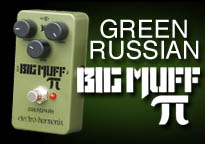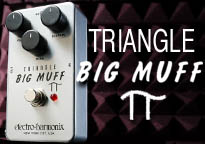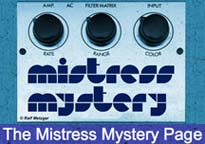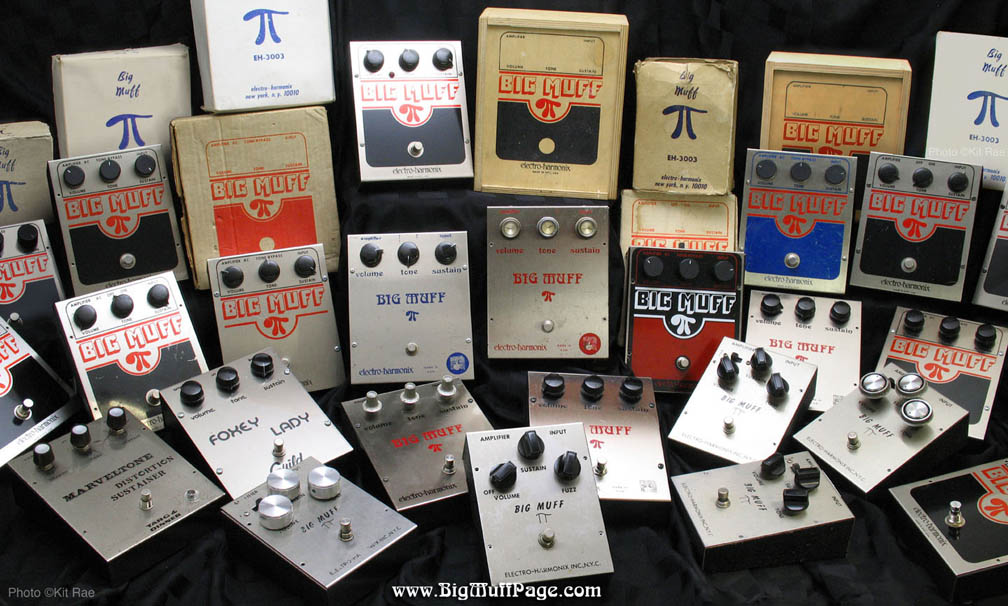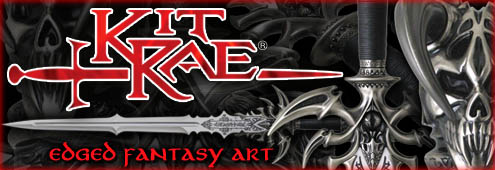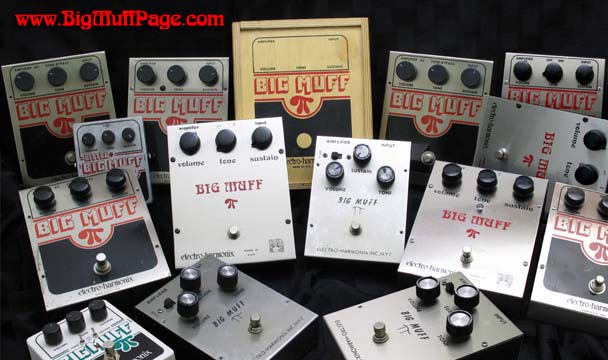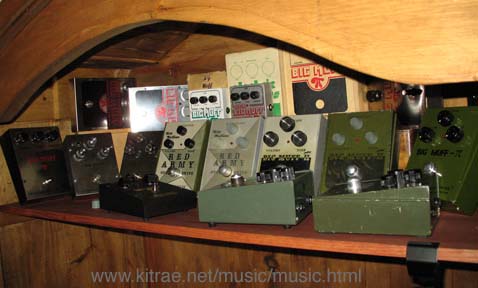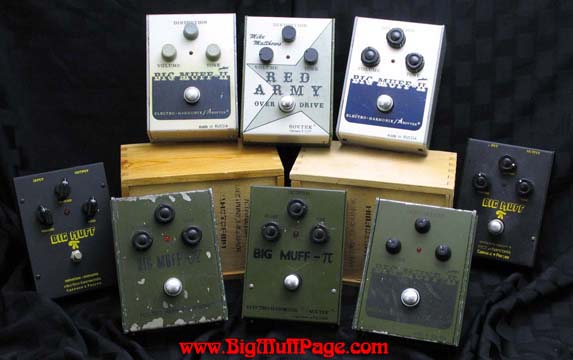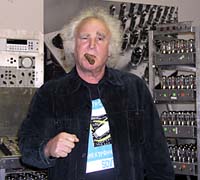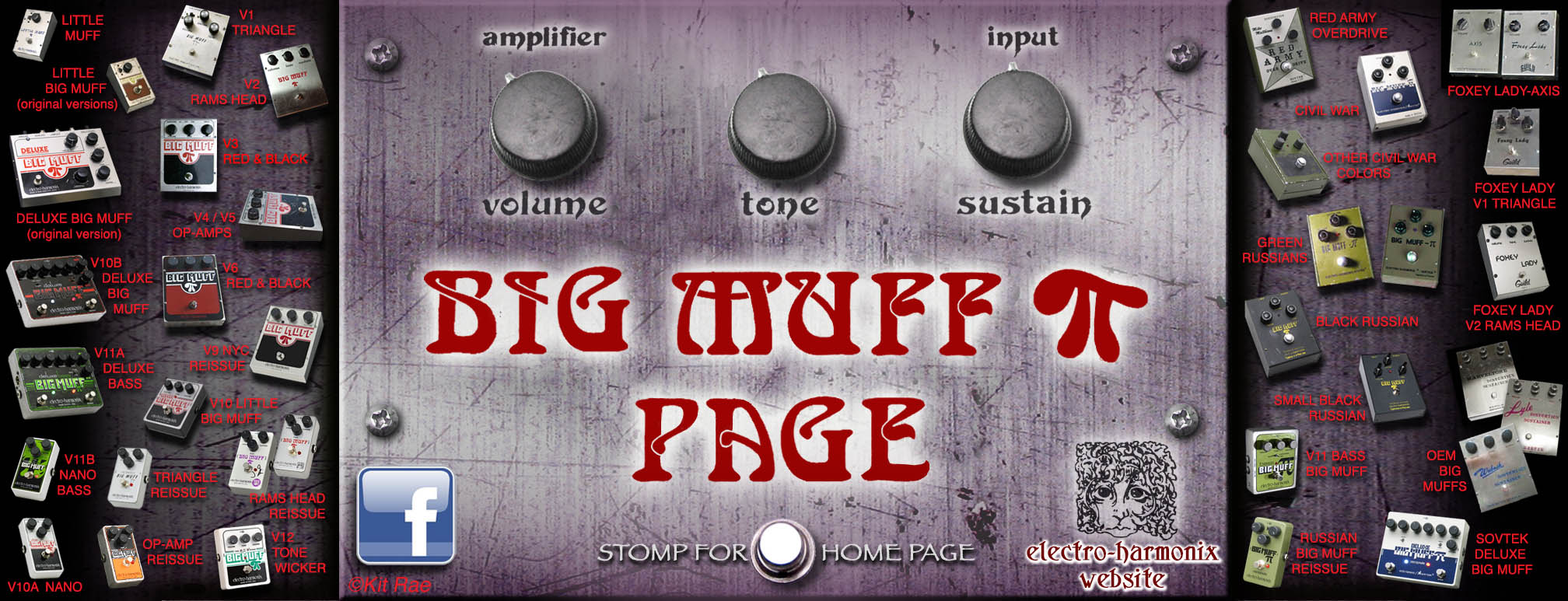
BIG MUFF PAGE NEWS - New Articles, New Additions, Demos, and Big Muff Updates
A HISTORY OF ALL VERSIONS PART 2 - Photos and detailed specs of every Russian Big Muff ever made!
A HISTORY OF ALL VERSIONS PART 3 - Photos and detailed specs of every Modern USA Big Muff ever made!
BIG MUFF VERSION QUICK IDENTIFIER - A Simple Summary of the Different Versions
• BIG MUFF SOUND CLIPS .........• REPLACEMENT BIG MUFF PARTS
• WIRING DIAGRAMS............... • BIG MUFF USERS
• OEM VERSIONS .....................• BIG MUFF CLONES AND KNOCKOFFS
• TIPS FOR BUYING A VINTAGE BIG MUFF ...................• BIG MUFFS CURRENTLY ON EBAY
• THE BIG MUFF CIRCUIT - A Simple Guide ................• HOW TO DISASSEMBLE A VINTAGE BIG MUFF.
• READING VINTAGE BIG MUFF POT DATE CODES
• A FUZZ AND MUFF TIMELINE - Release dates for all versions and dates for early fuzz pedals. .
• VINTAGE BIG MUFF REPLICAS and PEDALS INSPIRED BY THE BIG MUFF CIRCUIT
Updated 2014
INTRODUCTION - This website is dedicated to one of the most popular and cherished stomp boxes in the history of Rock and Roll, and my favorite distortion/fuzz box, The Big Muff π. There are very few websites dedicated to the Big Muff Pi, so I created this site with all of the information and history I have gleaned from various sources over the years, including some good photo references (pix from my collection, stolen from ebay auctions, and sent to me by other generous Big Muff owners) and audio clips. I think it is the most comprehensive one on the web. I have tried to sort out Muff fact from Muff fiction and clarify some confusing or contradictory details from other websites and articles, as well as include a comprehensive history about Electro-Harmonix and the story behind the origin of the Big Muff Pi for all you Muff junkies. Be aware that it is overly and obsessiveley detailed, to a level much deeper than the average person would care to know, and the person who put it together obviously suffers from some type of OCD! If you want the short and simple version, GO HERE.
The first Big Muff π was released to the world by Electro-Harmonix in 1969, and in full production in 1970 (not 1971 as many sources state), although variations of it appeared earlier than that. It was their second best selling pedal in the 1970s after the Small Stone phaser, and Mike Matthews said in 2017 that in terms of units sold for all versions, the Big Muff is their number one seller. Electro-Harmonix referred to the pedal as “The finest harmonic distortion-sustain device developed to date”, and it was. Fuzz pedals like the Maestro Fuzz-Tone and Fuzz Face were very popular in the late 1960s but the Big Muff was a very different and fresh take on the fuzz tone territory. The first well known recorded use of the Big Muff was in 1972 on The Carpenters' power ballad hit Goodbye to Love, with a hard rocking fuzz solo played by Tony Peluso, very ahead of it's time for the pop music market. Later the Big Muff made it into the rock and roll world with scores of other users, from Ernie Isley of the Isley Brothers, David Gilmour of Pink Floyd, J Mascis of Dinosaur jr, Billy Corgan of Smashing Pumpkins, to Jack White of The White Stripes. Even guitarists you would not expect have used them, like John Fogerty of Creedence Clearwater Revival, who is a collector of Russian Big Muffs (a detailed list of users can be found HERE).
The Big Muff used an independant four stage Silicon transistor based circuit that did not have the limitations of the typical guitar-into-fuzz circuits around at the time it was created. It could go anywhere in the signal chain, and the tone was not at the mercy of the temperature like the old style Germanium transistors used in Fuzz-Tone and Fuzz Face pedals. The Muff had monstrous loads of gain and sustain, and a monstrous sound to go along with it, from thunderous mud to hammering treble. It was the first fuzz pedal with such a huge bottom end, and it stepped on just about any typical fuzz pedal out there. There is a characteristic underlying harmonically-doubled octave sound mixed into the Muff tone, sometimes described as the Muffs "buzz" or "fizz". The tone sweep ranged from huge, dark, bassy sludge to thick, piercing, buzz saw treble, all with a deep mid range scoop. Somewhere in the middle was a sweet spot that just about anyone could dial in for their signature Big Muff tone.
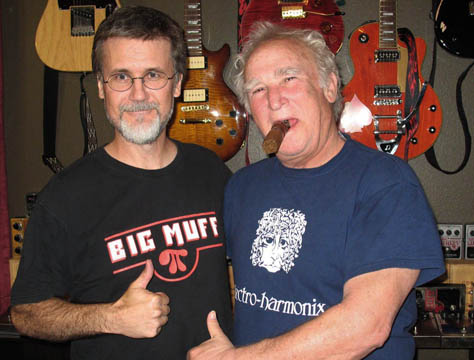
IS IT A FUZZ OR A DISTORTION? - The terms have become moot in the modern era. Technically fuzz / muff / distortion pedals all distort the audio signal, so they are all distortion pedals. "Fuzz" meant something specific in the 1960's when it was a unique fuzzy, gated distortion sound born of the first fuzz pedals - the Maestro Fuzz Tone, Vox Distortion Booster, Sola Sound Tone Bender, and Arbiter Fuzz Face. The Big Muff was a distinctly different type of distortion. Many distortion pedals released throughout the 1970's began to blur the lines of what a fuzz pedal sounded like, and in the 1980's the term fuzz kind of became outdated as "Distortion Pedal" became the common term. True fuzz pedals made a comeback in the 1990's, but the distinction between what was fuzz and what was not has long since passed. So, call it either a fuzz or a distortion if you like. I call it a Muff.
BIG MUFF ERAS - There are four primary eras of the Big Muff, each with their own unique tones, and each model having several variants, along with some other odd related models. They were first manufactured in the USA, then jumped over to Russia, then back to the USA again, and are now mostly assembled and tested in the USA, with parts made overseas. Many Big Muff users and collectors will tell you that every Big Muff sounds different, even among the same version, which is very true, but I think there are four unique tone eras that just about every Muff falls into:
The Vintage USA Big Muff Pi tones -V1 Triangle, V2 Ram's Head , V3, V6, Little Big Muff (original one knob version), Deluxe Big Muff (2014), Triangle Big Muff Reissue
The Vintage op-amp Big Muff Pi tones - V4,V5, Little Big Muff (op-amp version), Deluxe Big Muff "blend" version, Deluxe Big Muff "series/parallel" version, Op-Amp Reissue
The Sovtek Big Muff Pi tones - V7, V8, V11 Bass Big Muff , V14 Deluxe Bass Big Muff, , Deluxe Big Muff (2014), Green Russian Reissue, Deluxe Sovtek Big Muff
The Modern NYC Big Muff Pi tones -V9 USA reissue, V10 Little Big Muff, V12 Tone Wicker, Nano Big Muff, Deluxe Big Muff (2014)
Within each of those tone eras you can find slight variations, even within the exact same model, but they still have the characteristics of their own eras. The IC based Big Muffs like the V4 and V5 op-amp Muffs, the two Deluxe Big Muff op-amp versions, and the Little Big Muff op-amp version, are not really based on the Big Muff circuit, but they do have have similar clipped/scooped mids tones as the V3 Big Muffs, though perhaps less organic. They were called Big Muffs, and were intended to sound, and do sound like Big Muffs, so I am including them here. Click the link below for a short summary of the different Big Muff versions.
BIG MUFF π VERSIONS - A SIMPLE SUMMARY
WHAT DEFINES A VERSION? - One thing you may notice I have done on this website is to re-number the Big Muff π versions differently than what some other sources have used. I have included Russian made Big Muffs in the numbering sequence along with USA made versions, since there is a clear sequence to the manufacturing order, with just a bit of crossover. In my opinion, a true version change must involve a major change to the box shape, a change to the control layout, and/or a major change to the circuit. Graphics and color changes alone should not constitute a version change, especially since they changed so frequently. The sheer number of different versions of Big Muffs that have been made is one of the things that interested me in collecting and documenting them. Within each of the version changes I have tried to list all the variations in graphics and knob styles used, listing these as "editions" of a particular version. I call the numerous different circuits used in the Big Muff, circuit "variants". I have included many photos of the various circuit boards for reference to those of you interested in purchasing or learning about vintage Big Muffs. Hopefully these will aid in seeing the differences in board designs and components used throughout the years to help you determine if a Muff is all original or has been modified. There are also some tips for buying vintage Muffs in a link above, as well as links to other Big Muff websites. Note that I do not include some Big Muff variants here that are not actually built on the Big Muff tone circuit, such as the Muff Fuzz, Metal Muff, and Double Muff. None of those are actual Big Muff circuits, and none have any of the signature characteristics of a Big Muff's tone. Those items will be listed in a separate section (coming some day). Real Big Muff circuit variants like the two Deluxe Big Muffs and the vintage Little Big Muffs will be added soon. If you have anything Muffish to contribute to this website, find an error, or can clarify a detail or date, please contact me. If you want to read the inspiration for this website, check out this scan of an article from Vintage Guitar, March 1994.
Enjoy,
Kit
“I don’t think they (guitarists) buy the Big Muff because they are loyal, they buy the Big Muff because it has a unique tone character. The Big Muff is cascaded overdrive sections that go through diodes that clip, and that are filtered properly…so that you get a really sweet sustaining tone. And then you can still blend in a little edge with that. That’s the secret of the Big Muff.”
Mike Matthews in 2010
VERSIONS - How many versions of the Big Muff are there and what are the differences in the sound? That is a common question that many beginners to the Big Muff ask, and the answers I see on some websites vary from wildy inaccurate, to woefully incomplete. In their defense, it can be confusing considering all the different versions and wildly varying circuits. All Big Muffs have a similar scooped (removed) mid range characteristic, and a heavy, clipped distortion tone that is quite unique and "muffish" - but the variation in tones from version to version is quite broad, and there is variance in tone from unit to unit even of the same version. When we look at the circuits of the older Muffs, like the version 1 Triangle or version 2 Ram's Head Big Muffs for example, we see many circuit variants used over the years. These are not all different versions. The circuit schematics changed several times each year, which was normal operating procedure at Electro-Harmonix, and even occurs to a lesser degree in the modern EHX pedals.
"I’ve never done this, but if you were to take five Big Muffs from the same production line from 1973 and listen to all five, you would probably hear something different out of every one"
Mike Matthews, owner and founder of Electro-Harmonix."I introduced David to the Electro-Harmonix Big Muff Pi in 1974. He liked it, and he has continued to use one ever since. David has tried many of the different incarnations and models over the years, but his original has often been preferred for most things. Finding another that sounds the same is not easy, I have even placed six in a row that externally appeared to be identical to his original, and they all sounded different. Often, when you look inside, some components and values are different..."
Phil Taylor, Pink Floyd and David Gilmour's guitar and gear tech
WHY DO THEY ALL SOUND DIFFERENT? - If you hear or read a comment like "I think the Triangle Big Muff was the best version", or "The Ram's Head Big Muff version had the best sound" the person making that statement probably has only heard a single example. The fact is, there is no one Triangle schematic or one Ram's Head schematic that EHX followed, nor was there one sound for each. There were dozens of circuit variants. The basic circuit pathways are all the same, but the components in that circuit (capacitors, resistors, diodes, and transistors) each have different electronic values and properties. The selection of those set values make up the schematic used, and thus the sound. EHX often bought electronic parts cheaply and in bulk. They would make thousands of pedals using the on-hand stock of certain sets of values. When replenishing stock, they often bought the least expensive parts of similar values, but rarely the exact same sets of values. The schematic would then be modified to best work using the newly available parts stock, and thousands of pedals would be made using that circuit variant. This went on and on, resulting in dozens and dozens of circuit variants for the V1, V2, and V3 Big Muff Pi's. The circuit was very forgiving of these changes, but each variant did sound different. Some more so than others, but overall there are really only about four or five variants that sound distinctly different from each other. By the time the V6 Big Muff had come along in the late 1970's, the circuit had become consistent and standardized, but varying part tolerances meant that even those had some minor difference in sound from unit to unit. The V7 and V8 Russian Big Muff circuits were very consistent, with only three slightly different circuit variants used. However, when comparing examples using the same circuit variant, part tolerances made those sound slightly different from each other as well. The current V9 Big Muff has gone through several circuit revisions, as have the other modern Big Muffs.
WHICH BIG MUFF SOUNDS THE BEST? - That all depends on what kind of sound you are after. One person's favorite Big Muff may sound like garbage to another person. Depending on the circuit component values, there is a wide range of possible tones. You can have anything from the Isley Brother's Who's That Lady tone, David Gilmour-ish huge and articulate Pink Floyd tones, grungy/bluesy tones like the White Stripes or Black Keys, to Smashing Pumpkins, Dinosaur Jr. or Wata stoner/doom/drone "wall of sound" tones. V1, V2, and V3 run the gamut of different possible sounds due to the numerous circuit variants. Russian Big Muffs and the Bass Big Muffs are generally lower gain and bassy. The V9, V10 Little Big Muff and V12 Tone Wicker Big Muff have much more gain. Click the link below for a summary of the different Big Muff versions.
BIG MUFF π VERSIONS - A SIMPLE SUMMARY
Pristine Big Muff tones sound best through clean amps with lots of head room, but certain Muffs can also sound great in combination with small amps or amps with natural breakup. Another tonal exploration is to stack an overdrive pedal before or after the Big Muff, to create blended tones. Overdrives often blend well with them, and one of the best to use is the old Muff Fuzz/Little Muff from the 1970s, or the modern version, the Muff Overdrive.
VINTAGE VS MODERN - There is a lot of talk about vintage Big Muffs sounding better than modern Big Muffs, and I have heard it said to me many times that the V1 Triangle Big Muff sounds the best. In reality, there is not really a single Triangle circuit or single Ram's Head Circuit, as explained above. There were dozens of variants for each, and they both spanned the same wide range of possible sounds, because they both spanned the same wide range of possible clipping, feedback, and tone stack filter combinations. Most of the opinions I have heard, stating a Triangle Big Muff sounds like this, or a Ram's Head Big muff sounds like that, come from people who have only heard one or two examples of real vintage Big Muffs, or more likely, people who have only ever heard clones made from one or two specific circuit tracings. In reality, you could have a specific V1 variant from 1970 that exaclty matches the sound of a specific V2 made in 1974 or 1975 because the component values happen to be similar. You could also take a V1 made one year and compare it to a V1 made a year later and find they sound very different because they were each made with a different circuit variant. That is the reason so many sound different from each other, but it has little to do with when they were made.
The variety of Big Muff tones all amount to subtle changes in the component values that make one variant circuit sound different from another. You will find similar variations among other vintage pedals, such as the original Sola Sound Tone Benders or the Fuzz Face, though none as wide ranging in circuit variations as the Big Muff. Trying to pin down what makes one version sound different from another is tricky. I have tried to compare multiple examples of the different versions and specific circuit variants to get an accurate picture. The Big Muff tones from different time periods allow them to be somehwat grouped into general categories, as noted in the BIG MUFF ERAS section above.
A detailed explanation of the different versions and tonal differences can be found here.
Every now and then odd Big Muffs turn up with odd circuits and box graphics, sometimes mismatched with parts from versions that were made several years apart. Strange knobs can be explained because there were many knob types used, most shown on this website, and there are many Muffs around with replacement knobs. Other odd combinations are enclosures with graphics that do not match up with the pcb boards used at the same time, or LED on Big muffs that never had LEDs. There are several possibilities that could explain some of those oddities.
1. The Muff was defective, returned to Electro-Harmonix for repair or replacement under warranty, and EHX replaced the circuit board with a current production version on hand, but the graphics on the original box are from a previous version, or vise versa. That was likely a standard practice because it would have been less expensive to simply replace the whole circuit, pots and all, rather than to spend time trying to trace down which component was bad.
2. A previous owner, repair tech, or someone at a music shop may have combined components from one defective Muff (enclosures, knobs, circuits, switches) with components from from another defective Muff in an effort to make one sellable pedal. I have come across a few of these myself, and have actually done this myself with Muffs in my collection. Sometimes LEDs or power jacks were added to Big Muffs that did not include these features.
3. EHX discovered some older components (enclosures, knobs) in the factory warehouse and used them with a current production components to use them up. I have seen this happen with manufacturers I have worked with in the past, so I know it happens.
4. A tech has worked on the Muff at some point and replaced circuit components, switches or pots with newer ones that do not match the types originally used.
5. You have something unique that I do not know about, and you need to take photos and let me know about it right away :)
ENTER THE SITE FOR A HISTORY OF ALL BIG MUFF π VERSIONS
THANKS GO OUT TO ALL THOSE WHO HAVE HELPED OR CONTRIBUTED TO THIS SITE: Mike Matthews, Bob Myer, Howard Davis, Fran Blanche, John Pisani, Daniel Shin, Larry Demarco, Rick Stevenson, Kevin, Mark, Marc Ahlfs of Skreddy Pedals, Ron, Damian, Domenic, Brad, Jay, John, Carlos, Scott, Billy, Matt at Stomp Under Foot, Pawel, Sinner, the folks at the Gear Forum, Gilmour Gear Forum, FSB, D.A.M forum, and everyone else who has contributed that I forgot to mention! And extra big thanks to Mike Matthews for starting it all! And the Man upstairs!
This page is not authorized, affiliated, or associated with Electro Harmonix in any way, but we like their stuff and Mike is a cool dude!
Website and contents ©2007, ©2010, ©2013, ©2014 Kit Rae. All rights reserved. Linking to this website is allowed, but copying the text content is strictly prohibited without prior authorization. No part of this work may be reproduced, stored in a retrieval system, or transmitted in any other form, or by any means, electronic, mechanical, photocopying, recording, computer networking, or otherwise without prior permission in writing from the copyright holder(s).
Kit’s Secret Guitar, Gear, and Music Page
Guitar stuff, gear stuff, soundclips, videos, Gilmour/Pink Floyd stuff, photos and other goodies.
Contact: nasnandos @ kitrae.net
Copyright Kit Rae.
VISIT MY SWORDS, KNIVES and FANTASY ART WEBSITE www.kitrae.net



